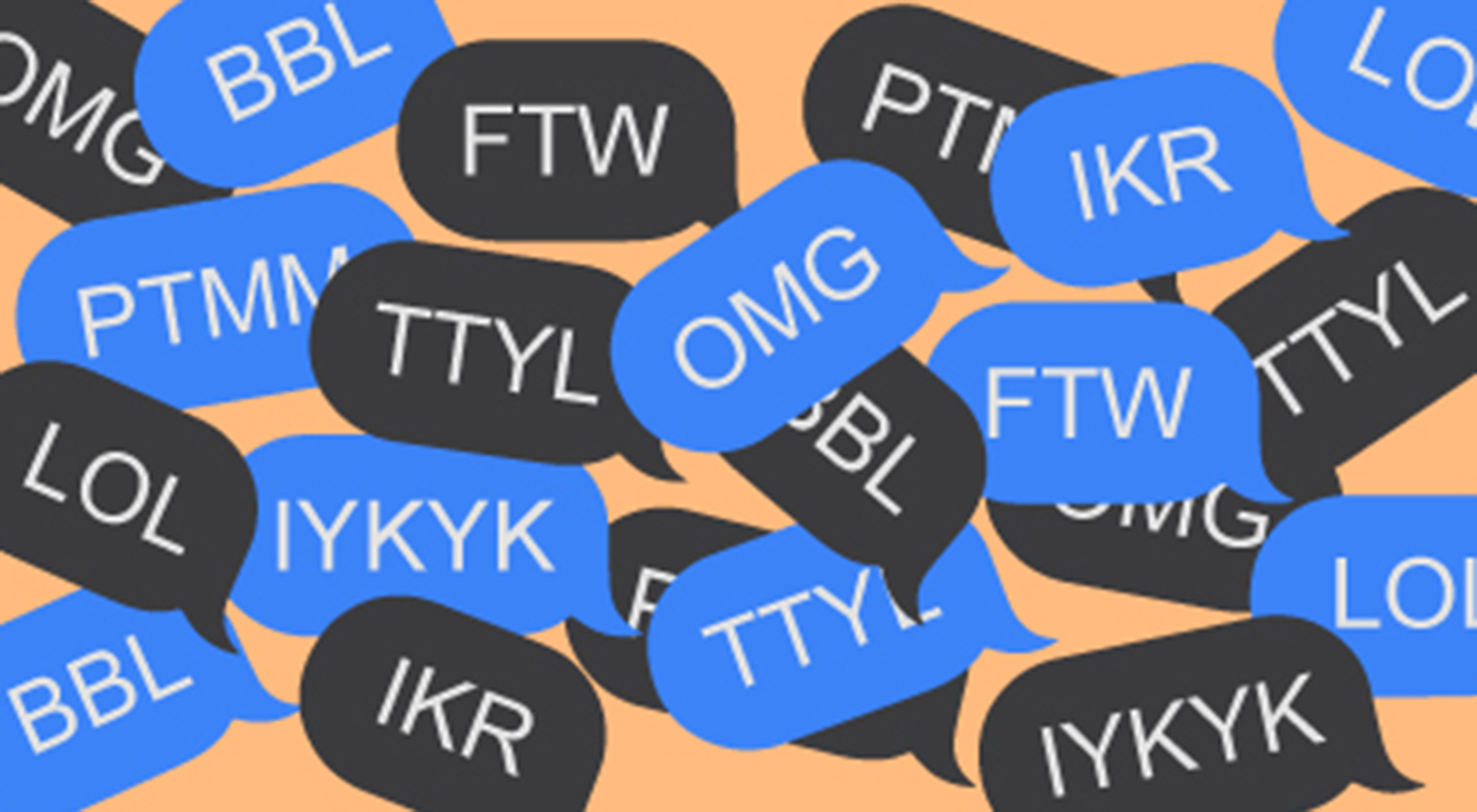Forget about which language is the official language of the United States, as ttmpaitus — aka textspeak: the most popular abbreviations in the United States — seems to have taken over on portable electronic devices everywhere, no matter what is the native language of the user. BTW, cmiiw, but afaik — imho tmot dqmot — irl ppl w/ tmi prolly rotflol w/ pm bau. UKTR? TTLY…
Textspeak: The Most Popular Abbreviations in the United States
…but what are the most popular textspeak abbreviations in the United States?
To find out the answer to that question, greater than 18 million geotagged messages from Twitter across every state were analyzed, allowing the usage rate of abbreviations by state or city to be compared to the national average.
To obtain the results of every state, geotagged messages were retrieved from Twitter in English for 207 cities in the United States, and then these messages from Twitter were aggregated based on the state to which each one belongs. A selection of abbreviations was searched in the contents of the messages from Twitter and included 250 of the most popular textspeak terms pulled from a Wiktionary page.
Next, the percentage of messages from Twitter that contain each abbreviation — usage of terms — for each state was calculated, and also at city level and national level. The most uniquely popular abbreviation for each location was defined as the term with the greatest difference between its national usage and its reference location usage. Although this methodology does not always yield the most-used term, it does provide the term that is most used compared to the national average.
Finally, each term usage was multiplied by 100,000 to obtain the average number of tweets that contain that abbreviation per 100,000 messages from Twitter.
The data was collected in October 2022.
This article from WordTips gives more details about the most popular textspeak abbreviations in the United States; and I have been given express written permission to use the graphs and the verbatim text from the aforementioned article in this article. While WordTips has endeavored to ensure the information provided is accurate and current, it cannot guarantee it, as this information is general in nature only and does not constitute personal advice. Neither WordTips nor The Gate accept any liability — and assume no responsibility — for any and all information which is presented in this article.
With that disclaimer out of the way, here is the article.
What Are The Most Popular Textspeak Abbreviations in the United States?
Your thumbs are very grateful.
All those abbreviations you learned to keep your SMS habit manageable have transferred seamlessly to the Twittersphere. And even when longer MMS messages came along and Twitter doubled its limit from 140 to 280 characters, the need for speed persisted. After all, we have less time today — and more to moan about, right?
And it’s not just about saving time. The simpler the act of writing becomes, the richer and more complex the writer’s expression can be.
The venerable OED gets this. (That’s the Oxford English Dictionary, not another textspeak abbreviation for you to learn.) As noted when the OED introduced OMG, LOL, and FYI into its pages, folk use initialisms not just to type more quickly but “to signal an informal, gossipy mode of expression, and perhaps parody the level of unreflective enthusiasm or overstatement that can sometimes appear in online discourse.”
In other words, a textspeak abbreviation is about both what you say and how you say it — all rolled into 2-4 plain letters. It’s an efficient labor-saving technology and a powerful ‘new’ form of communication. But where is all this power located? WordTips decided to trawl Twitter to find out which parts of America are using which initialisms the most.
What We Did
WordTips analyzed more than 18 million geotagged tweets across every state and the 50 biggest cities, and then calculated the average number of tweets (per 100,000) that contain common textspeak abbreviations. We also analyzed the usage rate of abbreviations by state compared to the national average to find each state’s most uniquely popular initialism.
Key Findings
-
- LOL is America’s favorite initialism, appearing in 1,411 out of every 100k tweets.
- Twitter users in Georgia use initialisms in 5,942 tweets out of every 100k — more than any other U.S. state.
- Only 2,125 tweets per 100k from Idaho contain textspeak abbreviations — the lowest rate in the U.S.
- Tbh is the most uniquely popular initialism in Illinois, Oregon, New Mexico, and Washington.
The Top Twitter Abbreviation in Every State
So what are the abbreviations that everyone’s using? Our first map shows the textspeak that Twitter users in each state use with disproportionate frequency compared to the national average. For example, the nice guys of Colorado use thx more than twice as often than the country as a whole. Colorado, which was once ranked the tenth most polite state by Canadians(!), is indeed super-polite for using the abbreviation for thank you so often. (Either that, or they’re the rudest for not bothering to spell it out when expressing gratitude.)
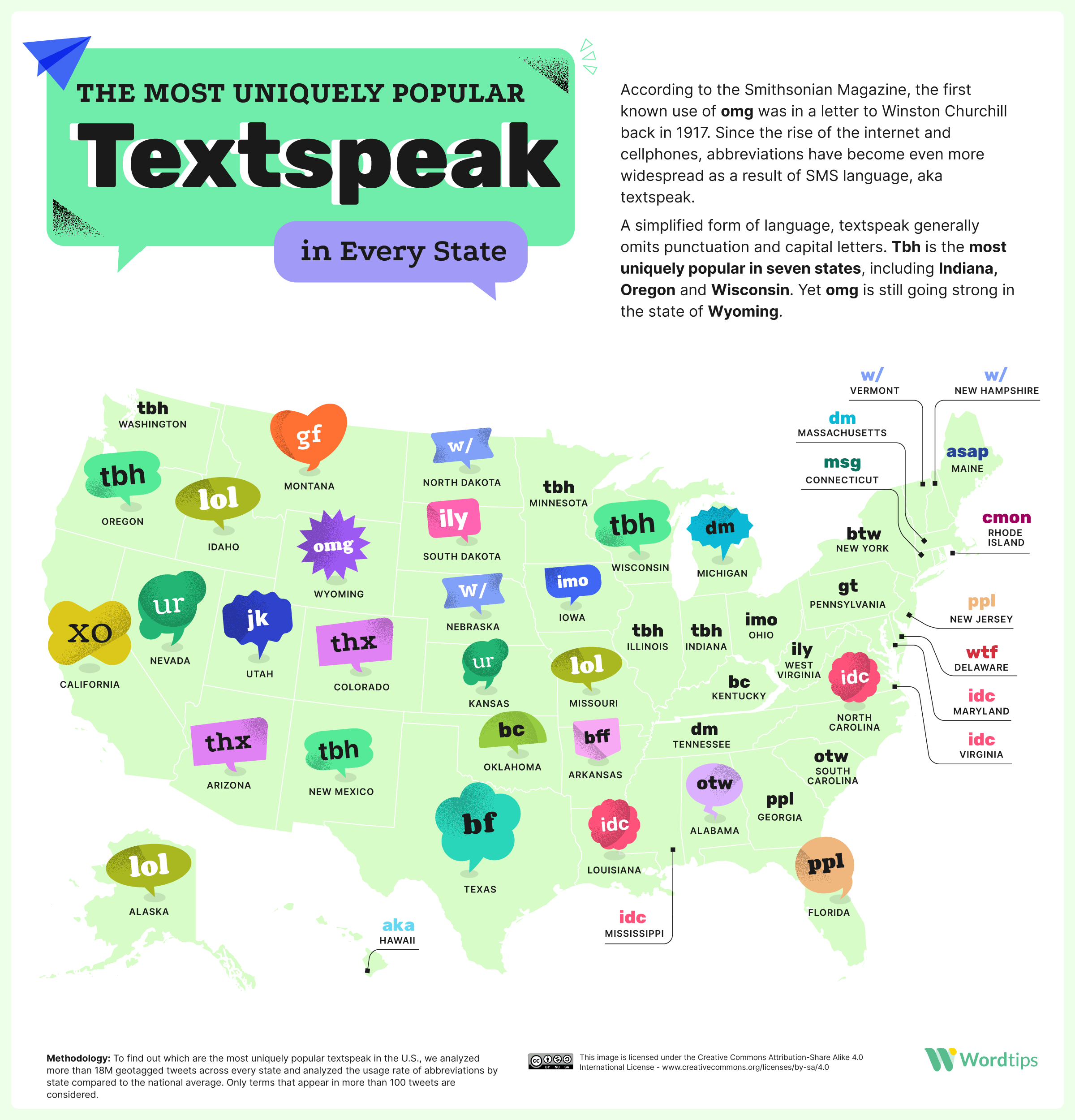
The map also reveals that North Central states have a tendency for frankness. Minnesota, Wisconsin, Illinois, and Indiana love “to be honest” (tbh), while South Dakotans declare their love (ily/I love you) on Twitter at a disproportionately high rate, and Iowans have an opinion that they’re not afraid to share (imo/in my opinion). The latter also peaks in Ohio. Its more precise variants — imho and imao (humble or arrogant opinion) — remain niche choices that are not outstandingly popular.
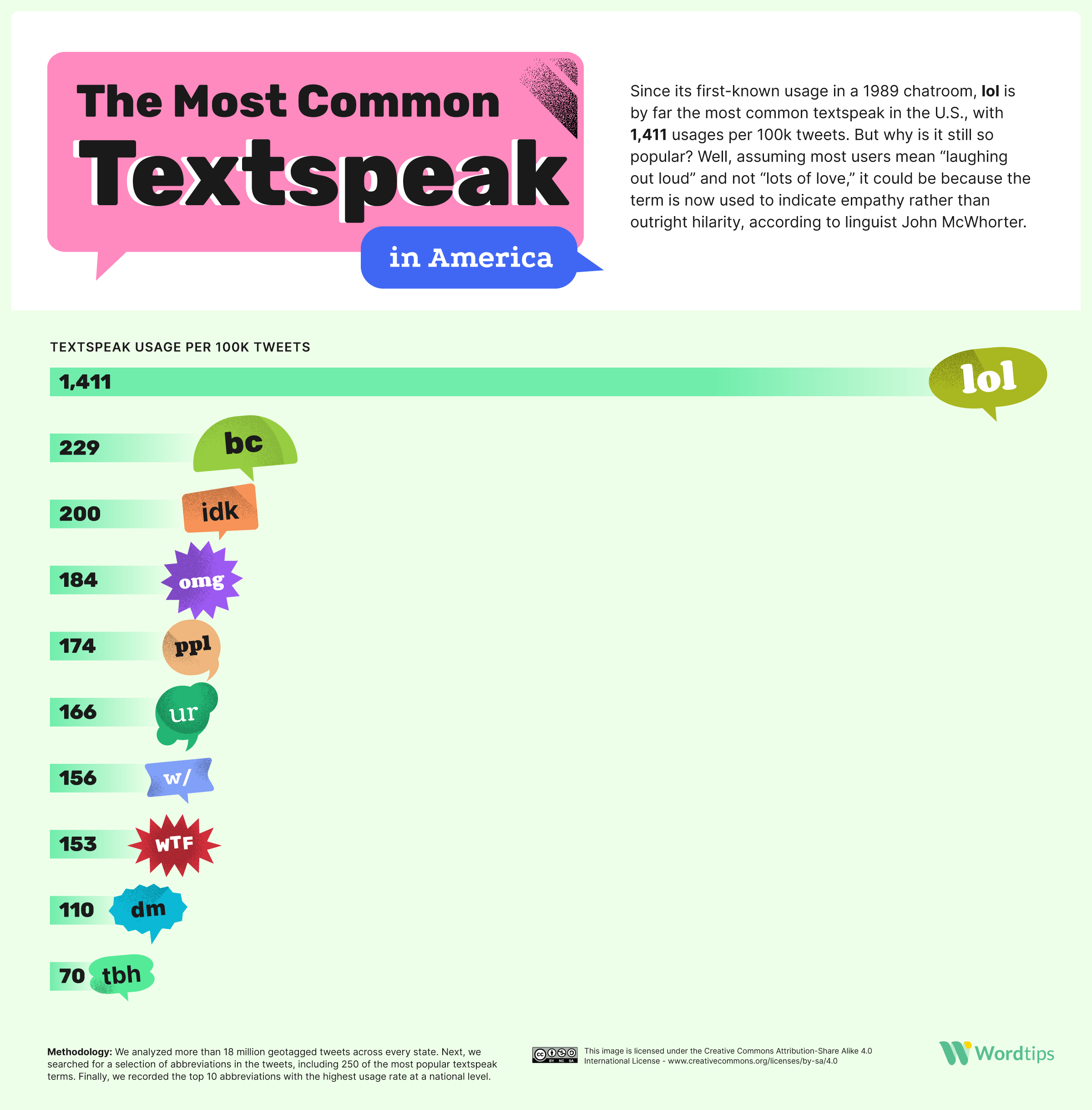
The above chart shows the textspeak abbreviations that are most popular across America. The winner, LOL, has become a living legend among initialisms, banishing similarly intended rivals LMAO and ROFL (laughing my ass off, rolling on the floor laughing) from the top ten altogether. Wayne Pearson of Calgary, Canada, was the first person to use the abbreviation in a chat room in the early 80s (according to Wayne Pearson.) But it hasn’t been an easy ride for LOL. Emojis and “haha” have impacted its popularity, although LOL has bounced back as its use has become ironic or even retro.
Twitter Users of Georgia Use the Most Abbreviations
It’s one thing to throw an occasional fml-bomb in with your tweets to add emotional context to your statement, but who in America is peppering Twitter most liberally with initialisms? It isn’t northerners: North Central states tend to use fewer abbreviations, and four of the five states that have an initialism rate lower than 2.5% (2,500/100k) are on America’s northern edge.
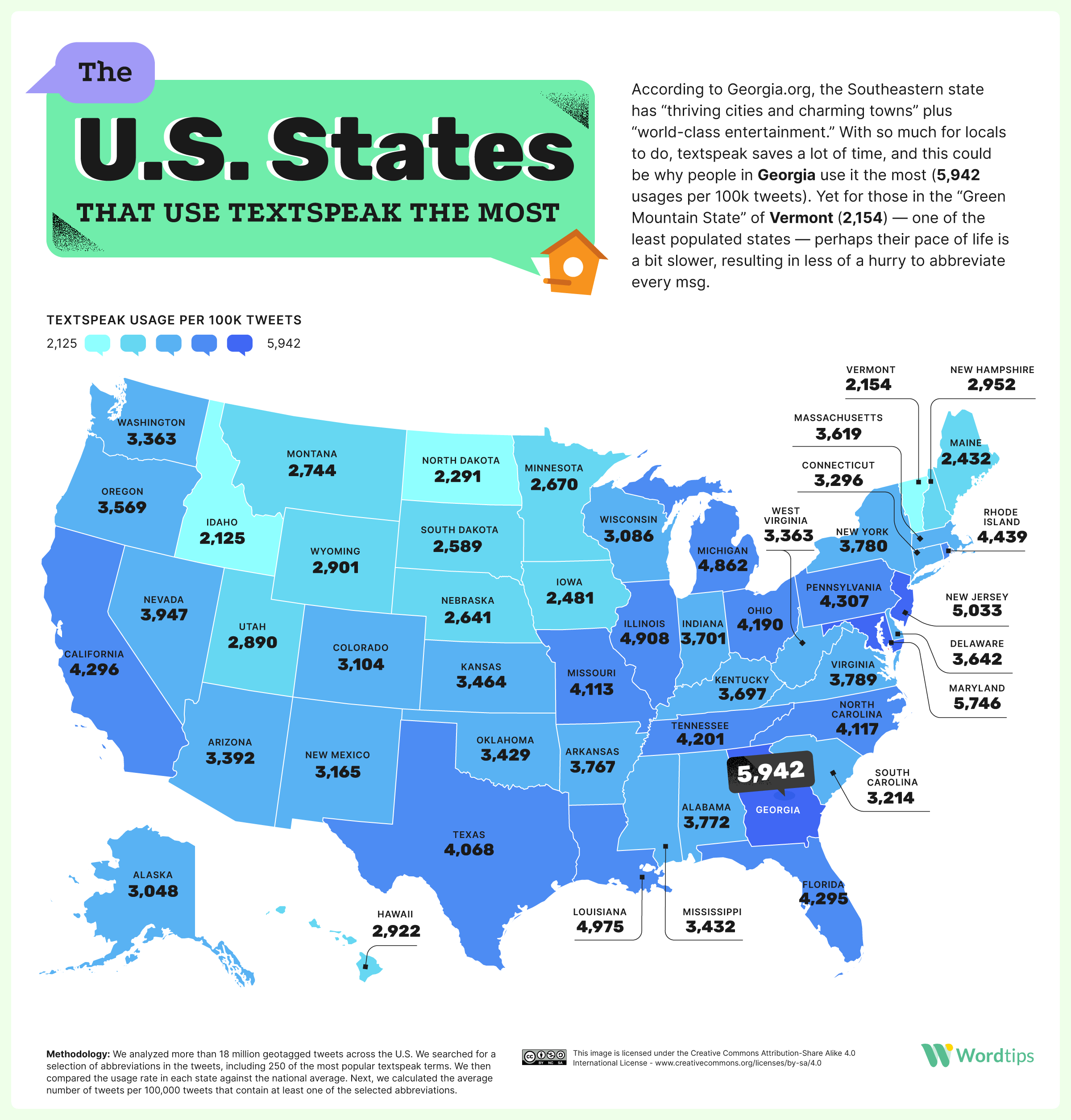
The ppl of Georgia use more initialisms than those of any other state (and yes, ppl is their most popular abbreviation). Georgia is one of three states to use more than 5,000 initialisms per 100k tweets. As researchers at the Georgia Institute of Technology found out, new words on Twitter “begin life in cities with large African-American populations before spreading more widely” — cities such as Georgia’s capital, Atlanta.
Milwaukee Residents Ask “What The Federation?”
Finally, we identified the initialisms that most stand out from city to city. East Coast cities tend to go for ppl or the ambivalence of an idk or idc (I don’t know/I don’t care). But New York is the only city to favor btw (by the way). This initialism goes back at least as far as the chat rooms of 1989 and can be used either in a helpful or snarky sense, depending on the context (and the New Yorker).
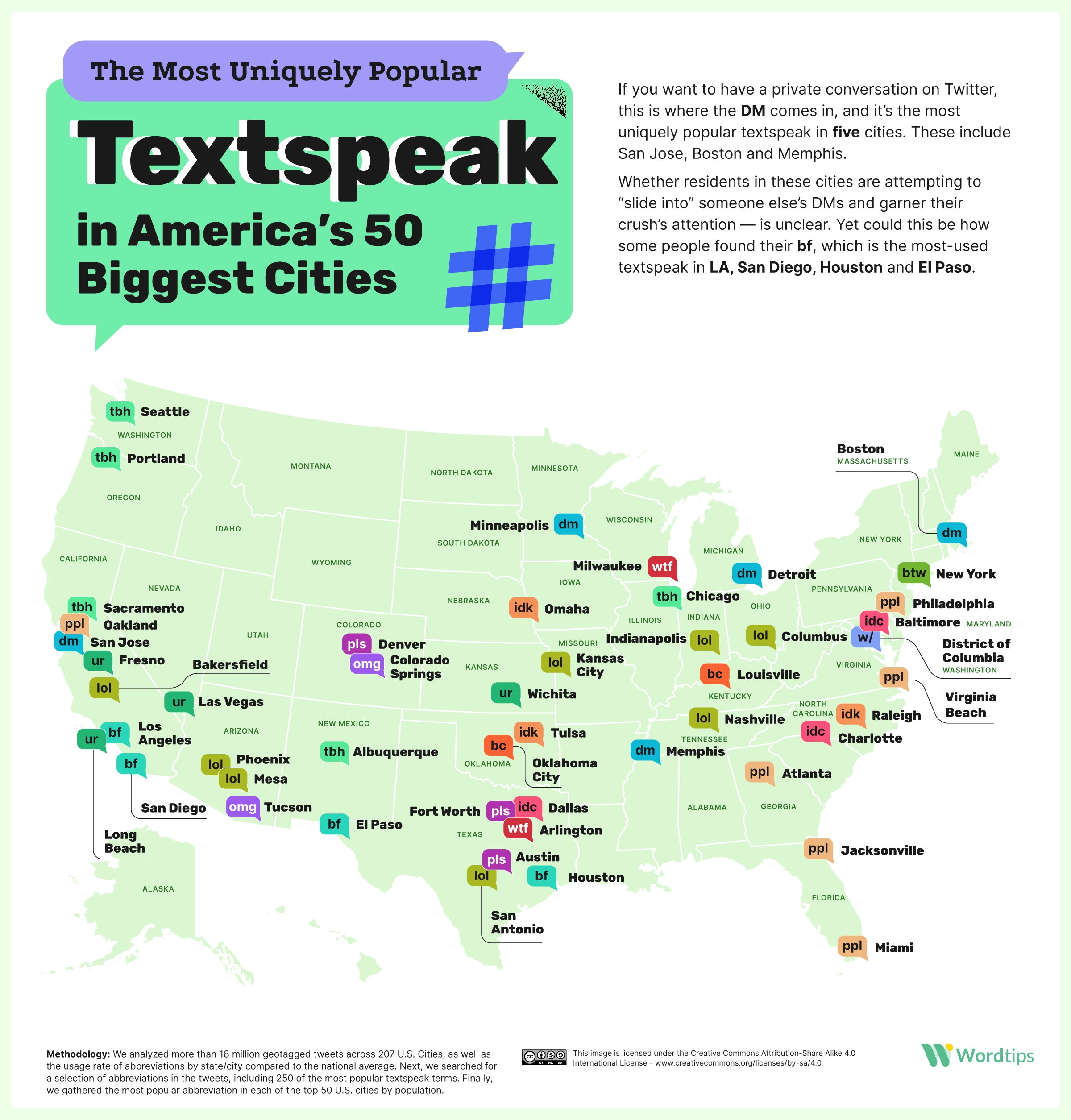
Confusion and/or outrage reign in Arlington and Milwaukee, where wtf (what the fuck?) is the most uniquely popular abbreviation. Or maybe they’re discussing classic taekwondo meets — the governing body of the martial art was called the World Taekwondo Federation (WTF) until June 2017 when the organizers got fed up with the double meaning and dropped the ‘Federation’.
This Isn’t Goodbye, It’s bfn (bye for now)
Twitter abbreviations have more uses than simply saving time and space. They can save the embarrassment of misspelling and cover up swear words, for example. Word gamers take note, too: while they can’t be used in Scrabble, trendy abbreviations turn up frequently as crossword clues. You can use our interactive table below to ascertain better the state of initialisms in the U.S. today.
The impulse to truncate predates both Twitter and SMS. Written communication has come with embedded labor-saving cheats for 2,000 years or more. For example, Runic alphabets were created to be straight and vertical, making them easier to carve into stone or wood, and medieval scribes used abbreviations 1,000 years back to save time and space as they copied books by hand.
New technology brings with it new communication habits and possibilities. In the metaverse, we may develop a new vernacular of gestures or other user-generated visual alerts. Meanwhile, in meatspace, wearable tech opens up a whole horizon of haptic (touchable) communication, such as vibration and temperature changes.
However, given how far back some of today’s textspeak Twitter abbreviations go, it’s likely we understand some of tomorrow’s slang already.
For a full list of terms used in our research please review the list below:
Final Boarding Call
Despite the fact that I do not like to use acronyms or abbreviations — let alone textspeak — whether I speak or write, I found this article to be surprisingly interesting…
…bwdik? ttfn. LOL
Graphic ©2023 by Brian Cohen.
